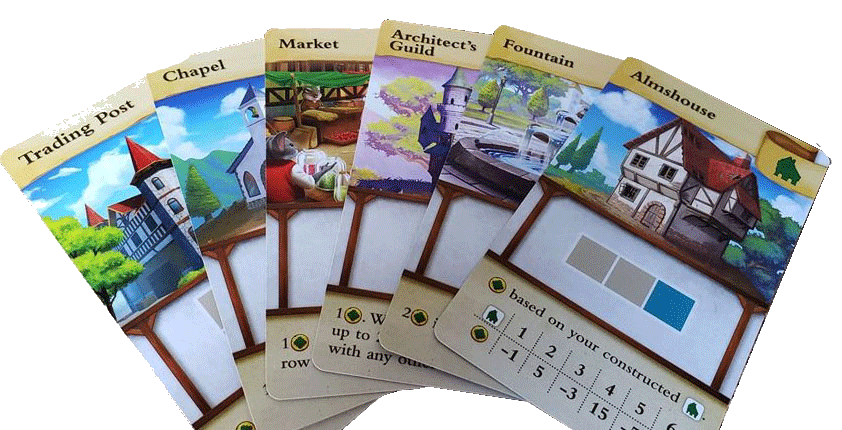
Each player’s tiny town is represented by an empty four by four grid, set down in front of them. During the game, they’ll place resources onto it, trying to lay them out in ways that will let them construct buildings later. These resources (each type represented by a different coloured marker) don’t turn up just by luck, and players can’t always choose whatever they want.
Rather, at each player’s turn, they become the master builder, and hold (just for that turn) the Master Builder’s Hammer. They alone choose a resource: one that suits their own needs and plans (stone, for example), and then everybody else also has to take one of that type, and place it onto their grid: like it or lump it.

Once a player’s got the right resources and in the right shape, they may construct a building: farm, factory, cottage or whatever.
As well as cottages, which are there in every game, there are twenty four other buildings, of which just six are on show each time. And it’s from this array that they can make their choice to build – all buildings can be built several times, and by several builders.
The smaller a building is, the less resources it’ll take to construct it. A cottage needs just brick, wheat, and glass, whereas a factory demands two brick, two stone, and one wood. Bigger buildings, though, are more powerful in terms of the extra opportunities they may bring during play, or the extra points at the end.
Each farm, for example, will provide food for up to four cottages. Each cottage that is fed will gain three points at the end of the game, whilst an unfed cottage gains none.
Don’t let the little people go hungry in Tiny Town. 🙂
Monuments are thrown into the melting pot too: Fort Ironweed is one such. Each player gets one (unseen by others) at the outset, and though they’re more resource hungry, their impact can be substantial, once built.
Tiny Towns is quite abstract in a way: one’s making shapes with different colours. It’s concerned with planning and using the space that’s available effectively and efficiently, and that calls for a certain amount of seeing what shapes could be developed: what could lead to building opportunities.
Further, although it might at first seem as though you should just get on with your own tiny little town, it soon becomes apparent that this isn’t a game where you can “go it alone” at all. It helps to watch what others are up to.
Players drop out from play once they can do no more on their tiny patch, and scores are worked out when the last tiny townee finishes. They’re not sitting out for long though … 🙂
Good fun additions and extensions
- somewhat abstract game
- easy to follow rules
- little setting up
- replayable
- strategic thinking develops with play
- low luck involved
- nicely competitive

► Looking for a small property?
